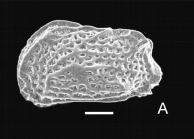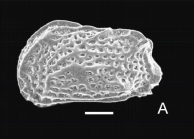WoRMS taxon details
Neohornibrookella trindadensis (Coimbra & Carreño, 2012)
1644887 (urn:lsid:marinespecies.org:taxname:1644887)
accepted
Species
Tenedocythere trindadensis Coimbra & Carreno, 2012 · unaccepted > superseded combination
marine, terrestrial
recent only
(of Tenedocythere trindadensis Coimbra & Carreno, 2012) Coimbra, J. C.; Carreño, A. L. (2012). Richness and palaeo-zoogeographical significance of the benthic Ostracoda (Crustacea) from the oceanic Island of Trindade and Rocas Atoll, Brazil. <em>Revista Brasileira de Paleontologia.</em> 15(2), 189-202., available online at http://www.sbpbrasil.org/revista/edicoes/15_2/RBP_07_Coimbra_&_Carreno_Final.pdf [details] Available for editors  [request]
[request]
Holotype UFRGS MP-O-2402, verbatimGeounit Trindade ...
Holotype UFRGS MP-O-2402, verbatimGeounit Trindade Island, Br... [details]
Description "Medium-size carapace. Sub-rectangular in lateral view; greatest height at the anterior cardinal angle; greatest width just...
Etymology "From the type locality, Trindade Island." (Coimbra & Carreño, 2012:196)
Description "Medium-size carapace. Sub-rectangular in lateral view; greatest height at the anterior cardinal angle; greatest width just after mid-length in the swelling area. Subcentrally, a smooth swelling slightly antero-ventral in position. Eye tubercle conspicuous. Dorsal margin straight and inclined towards the posterior where it is largely obscured by a lateral wing-like process. Anterior margin broadly and slightly asymmetrically rounded with a well-developed flange more visibly plicate in the ventral half. Posterior margin laterally compressed, concave above, sub-acute and truncated sub-ventrally with five to six, short, strong and commonly broken spines. Ventral margin straight with distinct antero-median concavity, partially hidden by a ventro-lateral alate rib. Surface covered with rounded to ovate fossae, somewhat subquadrate in dorsal, ventral and anterior regions. Sieve-type normal pores. An antero-marginal rib begins at the anterior cardinal angle, crosses the eye tubercle and runs parallel to the anterior margin being mid-ventrally very tenuous and ending in the antero-ventral margin. A somewhat blade-like dorsal rib runs parallel to the margin from the eye tubercle to the posterior cardinal angle where it forms a well-developed lateral wing-like process; ventral-lateral rib posteriorly alate. A rounded rib diverges from the dorsal rib, approximately at ⅓ from the posterior cardinal angle, and runs obliquely downwards passing above the subcentral weakly developed swelling and ending almost anterior to it. A second more delicate but conspicuous rib diverges from the antero-ventral margin and runs upward in a curved path and just anterior to the subcentral swelling abruptly recurves, crossing the swelling, and continues straight ending approximately at ¼ before the posterior margin. Ornamentation less developed in RV than in LV. In dorsal view, carapace moderately inflated. Internally, RV hinge has a strong triangular anterior tooth and a deep post-adjacent socket with a medial smooth groove ending in an oval knob-like posterior tooth. Adductor muscle scar pattern consists of a slightly oblique row of four elongate scars with two frontal smaller and ovate scars, situated in the subcentral depression. In LV, muscle scars slightly obscured and situated in a more antero-ventral position. Radial pore canals straight, simple and numerous. Inner lamella broad, narrow ventrally and incurved, line of concrescence and inner margin coinciding throughout. Males more elongate than females and with few developed alar processes." (Coimbra & Carreño, 2012:196) [details]
Etymology "From the type locality, Trindade Island." (Coimbra & Carreño, 2012:196)
Etymology "From the type locality, Trindade Island." (Coimbra & Carreño, 2012:196) [details]
Brandão, S.N.; Antonietto, L.S; Nery, D.G.; Pereira, J.S.; Praxedes, R.A.; Santos, S.G.; Karanovic, I. (2025). World Ostracoda Database. Neohornibrookella trindadensis (Coimbra & Carreño, 2012). Accessed through: World Register of Marine Species at: https://www.marinespecies.org/aphia.php?p=taxdetails&id=1644887 on 2025-04-11
Date
action
by
![]() The webpage text is licensed under a Creative Commons
Attribution 4.0 License
The webpage text is licensed under a Creative Commons
Attribution 4.0 License
Nomenclature
original description
(of Tenedocythere trindadensis Coimbra & Carreno, 2012) Coimbra, J. C.; Carreño, A. L. (2012). Richness and palaeo-zoogeographical significance of the benthic Ostracoda (Crustacea) from the oceanic Island of Trindade and Rocas Atoll, Brazil. <em>Revista Brasileira de Paleontologia.</em> 15(2), 189-202., available online at http://www.sbpbrasil.org/revista/edicoes/15_2/RBP_07_Coimbra_&_Carreno_Final.pdf [details] Available for editors  [request]
[request]
new combination reference Warne, M. T.; Whatley, R. (2016). <em>Neohornibrookella sorrentae</em> (Chapman and Crespin, 1928) and allied ostracod taxa from the Neogene of southeastern Australia: Systematic and palaeoceanographical relationships, palaeoecology and palaeobiogeography. <em>Marine Micropaleontology.</em> 125: 110-133., available online at https://doi.org/10.1016/j.marmicro.2016.04.003 [details] Available for editors [request]
[request]
new combination reference Warne, M. T.; Whatley, R. (2016). <em>Neohornibrookella sorrentae</em> (Chapman and Crespin, 1928) and allied ostracod taxa from the Neogene of southeastern Australia: Systematic and palaeoceanographical relationships, palaeoecology and palaeobiogeography. <em>Marine Micropaleontology.</em> 125: 110-133., available online at https://doi.org/10.1016/j.marmicro.2016.04.003 [details] Available for editors
Other
additional source
Luz, N. C. D.; Coimbra, J. C. (2022). Ostracods (Crustacea: Ostracoda) of the Vitoria-Trindade Chain, southwestern Atlantic. <em>Zootaxa.</em> 5188(4): 301-329., available online at https://doi.org/10.11646/zootaxa.5188.4.1 [details] Available for editors  [request]
[request]
Holotype UFRGS MP-O-2402, verbatimGeounit Trindade Island, Br... [details]
From editor or global species database
Description "Medium-size carapace. Sub-rectangular in lateral view; greatest height at the anterior cardinal angle; greatest width just after mid-length in the swelling area. Subcentrally, a smooth swelling slightly antero-ventral in position. Eye tubercle conspicuous. Dorsal margin straight and inclined towards the posterior where it is largely obscured by a lateral wing-like process. Anterior margin broadly and slightly asymmetrically rounded with a well-developed flange more visibly plicate in the ventral half. Posterior margin laterally compressed, concave above, sub-acute and truncated sub-ventrally with five to six, short, strong and commonly broken spines. Ventral margin straight with distinct antero-median concavity, partially hidden by a ventro-lateral alate rib. Surface covered with rounded to ovate fossae, somewhat subquadrate in dorsal, ventral and anterior regions. Sieve-type normal pores. An antero-marginal rib begins at the anterior cardinal angle, crosses the eye tubercle and runs parallel to the anterior margin being mid-ventrally very tenuous and ending in the antero-ventral margin. A somewhat blade-like dorsal rib runs parallel to the margin from the eye tubercle to the posterior cardinal angle where it forms a well-developed lateral wing-like process; ventral-lateral rib posteriorly alate. A rounded rib diverges from the dorsal rib, approximately at ⅓ from the posterior cardinal angle, and runs obliquely downwards passing above the subcentral weakly developed swelling and ending almost anterior to it. A second more delicate but conspicuous rib diverges from the antero-ventral margin and runs upward in a curved path and just anterior to the subcentral swelling abruptly recurves, crossing the swelling, and continues straight ending approximately at ¼ before the posterior margin. Ornamentation less developed in RV than in LV. In dorsal view, carapace moderately inflated. Internally, RV hinge has a strong triangular anterior tooth and a deep post-adjacent socket with a medial smooth groove ending in an oval knob-like posterior tooth. Adductor muscle scar pattern consists of a slightly oblique row of four elongate scars with two frontal smaller and ovate scars, situated in the subcentral depression. In LV, muscle scars slightly obscured and situated in a more antero-ventral position. Radial pore canals straight, simple and numerous. Inner lamella broad, narrow ventrally and incurved, line of concrescence and inner margin coinciding throughout. Males more elongate than females and with few developed alar processes." (Coimbra & Carreño, 2012:196) [details]Diagnosis "Medium size. Surface with well-developed ornament of rounded to ovate fossae, somewhat subquadrate in dorsal,ventral and anterior regions. Ribs scarce and mainly oblique; ventro-lateral rib posteriorly alate. A well-defined wing-like process protrudes on the postero-dorsal margin. Eye tubercle conspicuous and crossed by the antero-marginal rib." (Coimbra & Carreño, 2012:196) [details]
Dimensions "holotype: MP-O-2402 Female LV, Length 0,52, Height 0,34" (Coimbra & Carreño, 2012:196) [details]
Etymology "From the type locality, Trindade Island." (Coimbra & Carreño, 2012:196) [details]


